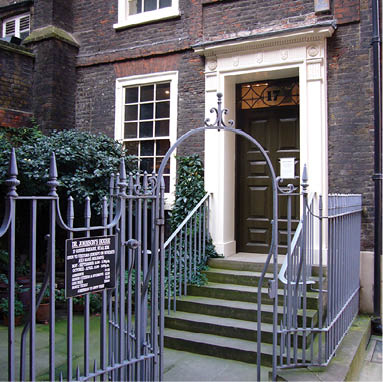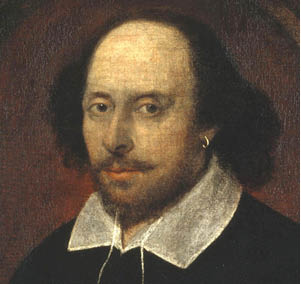Getting Around London


Pedestrians take over the Mall in Central London on Sundays.
London is a walking town. Much of the city core is a maze of narrow, winding backstreets and cobblestone lanes leading to hidden courtyards. A street map is useful for exploring London’s West End and Square Mile on foot, and the pocket-sized Mini London A-to-Z Street Atlas provides excellent detail. The River Thames meanders through the heart of London, flowing past some of London’s most famous landmarks, making it easy to maintain your bearings while walking along the Embankment.
Also pleasant for walking are the city’s interconnecting parks – St. James’s Park, Green Park and Hyde Park. The Mall (closed to vehicle traffic on Sundays) leads past St. James’s Park and Green Park to Buckingham Palace. A variety of walking tours are offered by London Walks (walks.com).
There are, of course, alternatives to walking. Red double-decker sightseeing buses (operated by Big Bus Tours) follow two heritage routes and have boarding points near major landmarks and attractions throughout Central London. Commentary is provided, as are hop-on/hop-off privileges. You can purchase tickets beforehand online or through your travel agent. An all-day (24-hour) ticket is about £22 per adult. Several river boat firms service the Thames, providing both commuter service and narrated cruises for tourists. Fast river buses operate daily from Embankment pier and Waterloo (London Eye) pier, and river cruises are available between Westminster, Waterloo, Embankment, Tower and Greenwich piers, with longer trips available to Kew, Richmond and Hampton Court. River service also connects the Tate galleries, running between Millbank (Tate Britain) and Bankside (Tate Modern). Ticket information is posted at the piers, and Travelcard holders receive a discount.
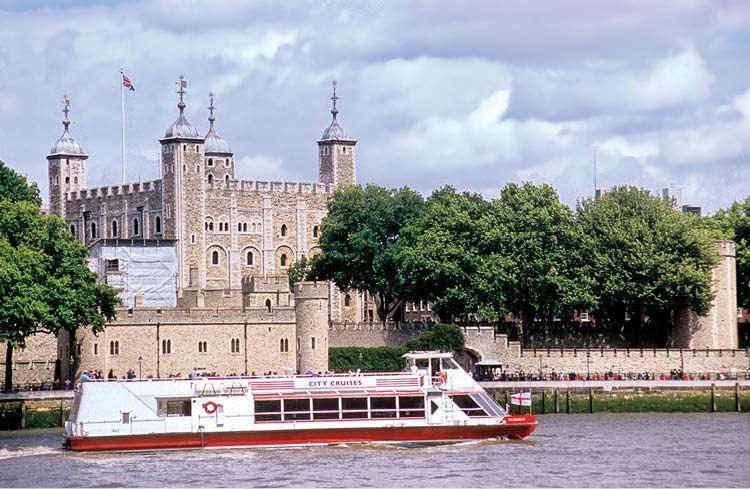
River boat tours give a unique perspective on the city.
The Underground (called the Tube) is an efficient way to get quickly from one point to another (www.thetube.com). Tickets can be bought at ticket windows inside the station. A flat-fee, all-day ticket is a good option, as are the various travel cards available through Rail Europe, including the Visitor Oyster Card (an electronic, refillable go card) and the London Travel Card, which provides unlimited travel on public transport (underground rail and buses). You can combine a London Travel Card with a London Pass, which provides single or multi-day access to dozens of London attractions and features fast-track entry past lineups at the popular venues. For more information on travelling around London by tube, rail, bus or riverboat, visit Transport for London (tfl.gov.uk).
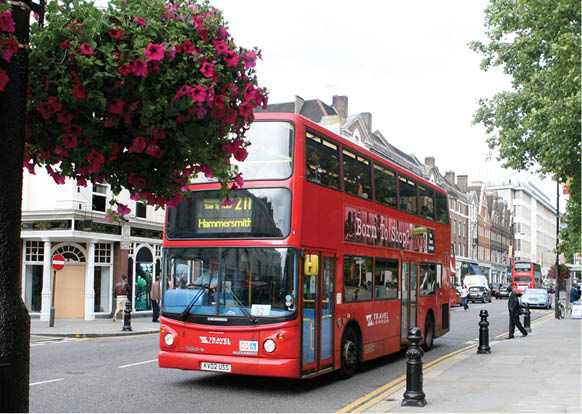
Public transport in London includes buses and the Tube.
If you’re travelling with two or three others, getting around London by taxi is an affordable alternative to public transport. London’s distinctive black taxi cabs can be hailed anywhere and their drivers know the city like the back of their hand. They undergo extensive training to acquire their knowledge, which entails studying the Blue Book’s 25,000 streets located within a six-mile radius of Charing Cross (the geographic centre of London). It takes a licensed cabbie several years to learn all of the streets and possible routes in Central London. To pass the licensing test, a successful candidate must be able to take a passenger to any destination requested without the aid of a map. Be sure to use the licensed taxis and not the unlicensed minicabs.
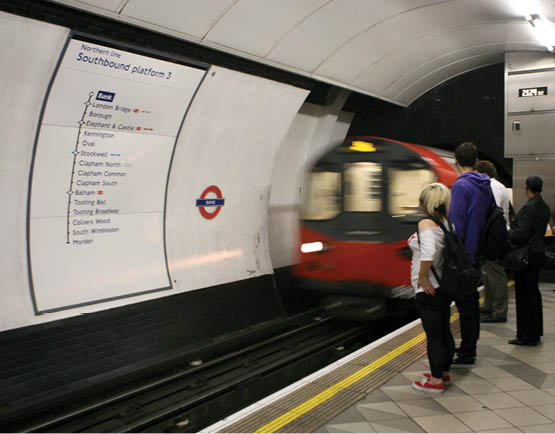
The Tube is an excellent way to get around London.
One approach to exploring London is to determine beforehand the attractions you want to visit that day, then take a cab, bus, river boat or the Tube to the point furthest from your hotel. After visiting the first attraction on your list, set off on foot in the general direction of your hotel. Walk to as many sites as you feel able, stopping along the way for refreshments, then hail a taxi back to your hotel (unless it’s rush hour, when taking the Tube or walking are much faster).
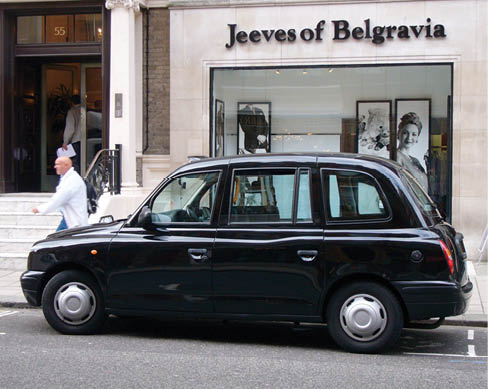
A classic London taxi car.
Renting a car in London is not recommended. Traffic is heavy, fast-moving and driving is on the left. There are also numerous traffic circles (the word ‘circus’ is Latin for ‘ring’ and refers to a roundabout of converging streets, such as Piccadilly Circus). Should you decide to drive in London, also be aware of a £10 daily congestion charge levied on any private vehicle that drives through central London during peak business hours (7:00 a.m. to 6:00 p.m., Monday through Friday). Motorists’ licence plate numbers are recorded by 800 cameras monitoring the 160-plus entry points to the Central Zone.
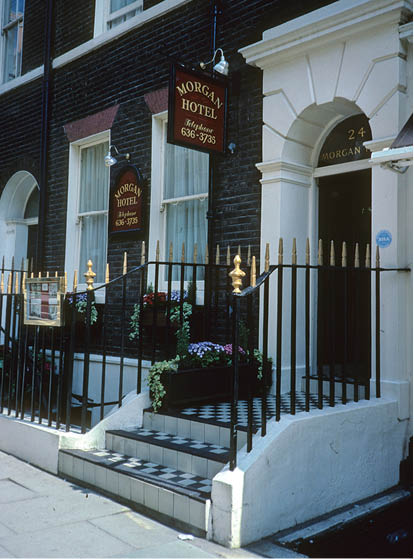
The Morgan Hotel is a popular B&B hotel in Bloomsbury.
London is one of the world’s most expensive cities and hotel prices reflect this reality. Five-star hotels in London are plentiful and are concentrated in Mayfair and St. James’s. These include The Mayfair, The Stafford (St. James’s), The Connaught (Mayfair), Claridge’s (Mayfair) and The Dorchester (Park Lane). The Grosvenor House, originally built as a private mansion for the Grosvenor family, is a five-star Marriott property on Park Lane. The Lanesborough is a St. Regis Hotel at Hyde Park Corner, and The Ritz is on Piccadilly overlooking Green Park.
Recently opened luxury hotels include the Corinthia Hotel in Whitehall and the Shangri-La in The Shard, on the south bank of the Thames near London Bridge.
Luxury boutique hotels include Dukes (St. James’s Place) and Brown’s, which opened in Mayfair in 1837. The family-owned Goring Hotel, near Buckingham Palace in the posh Belgravia district, is where Kate Middleton stayed with her family the night before her wedding to Prince William.
The Savoy, one of London’s most illustrious hotels, is located on the Strand overlooking the Victoria Embankment and recently underwent a major renovation while retaining the interior’s unique blend of Edwardian and art-deco decor.

A four-star Thistle Hotel.
Hazlitt’s Hotel (Soho) is a four-star boutique hotel located in the heart of the theatre district. For families, Thistle Hotels are a good choice in the four-star category.
For three-star budget accommodation, good choices are the family-owned Morgan Hotel on Bloomsbury Street near the British Museum, or The Fielding Hotel near Covent Garden.
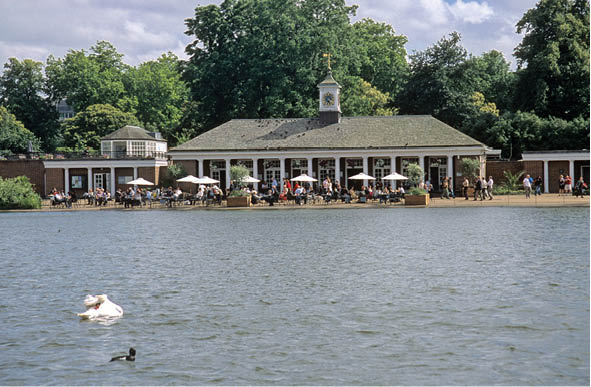
Casual diners enjoy an outdoor café in Hyde Park.
A traditional English breakfast consists of eggs, bacon or sausages and dry toast served with marmalade. Afternoon tea consists of finger sandwiches, warm scones and sweet pastries – all served, of course, with tea. The traditional British pub is the place to go for pub grub, such as the ploughman’s plate of ham, cheeses and bread, washed down with a pint of lager or ale. If you want to eat well in London without blowing your budget, the city’s gastro pubs serve fine food in a casual setting. Other options include fixed-price lunches and pre-theatre dinner menus.
When touring London, you can enjoy a convenient lunch onsite at many of the city’s popular attractions. Restaurant choices include the New Armouries Restaurant at the Tower of London (lunch fare in a cafeteria-style setting); the Tate Modern’s top-floor restaurant overlooking the Thames; The National Gallery’s Oliver Peyton restaurant (serving classic British dishes) or its street-level café; the rooftop restaurant or the casual café at The National Portrait Gallery; and The Orangery restaurant beside Kensington Palace (serving lunch and traditional afternoon tea). The Wallace Collection’s courtyard restaurant is another pleasant place for lunch or afternoon tea.
In fair weather, the outdoor cafés in Hyde Park are pleasant places to stop for refreshment. Shoppers can dine at one of the restaurants in Fortnum & Mason on Piccadilly or choose from the amazing assortment of restaurants and foodstands in Harrods department store.
Michelin-starred restaurants abound in London, with many overseen by celebrity chefs such as Gordon Ramsay who runs several London restaurants, including the Savoy Grill. Alain Ducasse at The Dorchester enjoys three stars for creative French cuisine. Fine dining in the English tradition is offered at Wiltons (est. 1742) in St. James’s. The Ivy, near Leicester Square, is London’s favourite theatre restaurant (reservations recommended). In Chelsea, Tom’s Kitchen serves dishes by Tom Aikens in the relaxed setting of a converted pub.
Cecconi’s in Mayfair serves some of the best Italian cuisine in London, but if you’re looking for good Italian food at a more modest price, the Bella Italia has numerous locations in London, including one off St. Martin’s Lane, just steps from The National Gallery. Also recommended is the family-owned Taormina in Bayswater, near Lancaster Gate tube station.
Several of London’s famous watering holes are found in the luxury hotels of the city’s Mayfair and St. James’s districts. These include Dukes Bar at Dukes Hotel, which is famous for its martinis and is where author Ian Fleming, creator of James Bond, is said to have heard a bartender describe a martini as shaken, not stirred. Another swank bar in the upscale St. James’s district is the American Bar at The Stafford (not to be confused with the American Bar in The Savoy).
Mayfair’s famous establishments include the Champagne bar at Scott’s Restaurant & Bar on Mount Street and Donovan Bar in Brown’s Hotel. (Men should note that a jacket may be required at some of these establishments.)
For a more casual atmosphere, The Only Running Footman (on Charles Street near Berkeley Square) is a quintessential British pub/restaurant which is popular with locals and tourists. Also in Mayfair, on Mill Street, is the Windmill pub, famous locally for its steak and kidney pie. The Anglesea Arms in South Kensington is another gastro pub serving bar snacks and burgers.
Right beside Charing Cross train station on Northumberland is The Sherlock Holmes pub and restaurant, a favourite with locals since the 1960s. Ye Olde Cheshire Cheese, approached by a narrow alleyway (Wine Office Court) off Fleet Street, is one of London’s oldest pubs and a great place to pause for a pint.
London’s red-hot club scene attracts a young crowd of wealthy aristocrats and celebrities. One of the most popular is the Polynesian-themed Mahiki Club on Dover Street in Mayfair, which is run by a friend of Prince William.

The famous Palace Theatre in London’s West End is where Les Misérables played for 19 years.
Charles Dickens called London a “magic lantern” – an apt description for the city’s commercial theatre, which is second to none. The West End’s famous theatre district (Theatreland) is housed in late Victorian buildings located in and around Leicester Square where long-running musicals include The Phantom of the Opera, Chicago, Mamma Mia! and Les Miserables.
To obtain discount and half-price tickets on the day of a performance, visit the TKTS booth in the clocktower building in the centre of Leicester Square (open daily from 10:00 a.m. to 7:00 p.m. except from 11:00 a.m. to 4:30 p.m. on Sundays). Tickets can only be bought only in person from the windows, and popular shows usually sell out early.
London is also famous for its non-commercial theatres, such as the National Theatre (South Bank), the Globe Theatre (Bankside) and the Old Vic (Lambeth), which stage classic and modern works by leading playwrights. The Royal Opera House, at Covent Garden, is where the Royal Ballet and Royal Opera perform.
There are two main shopping areas in London’s West End. One is centred on Oxford Street, Regent Street and Piccadilly Street in Mayfair; the other is in Knightsbridge, which is the location of Harrods department store and the high-end boutiques along Sloane Street.
Oxford Street is the major shopping street in London and considered the flagship location of numerous chain stores such as Marks & Spencer, H&M and Topshop. At the west end of Oxford Street is the famous Selfridges department store. Oxford Street intersects with Regent Street at Oxford Circus, and just south of this intersection is Hamleys, one of the world’s largest toy stores. Other stores along Regent Street include Liberty, Burberry and Austin Reed.
Regent Street crosses Piccadilly Street at Piccadilly Circus – an enormous traffic circle filled with movie theatres. Just west of Piccadilly Circus on the south side of Piccadilly Street is Fortnum & Mason, founded in 1707 and famous for its gourmet food hampers. One block west, at the corner of Jermyn and Bury, is the exclusive clothier Turnbull & Asser – whose famous clients have included Winston Churchill, Ronald Reagan and Prince Charles, who has bought shirts here since his youth.
The Piccadilly Arcade, lined with upscale shops, runs between Piccadilly and Jermyn, the latter connecting at its west end with St. James’s Street, which is where London’s most famous hat maker – Lock & Company – is located. The inventor of the bowler hat, this family-owned business was founded by James Lock in 1676 and has been at its current location (6 St. James Street) since 1765. Customers have included Oscar Wilde, Winston Churchill, Frank Sinatra and Johnny Depp. Also on St. James’s Street (#71) is Truefitt & Hill – “Barbers to British Royalty since 1805” – which sells luxury grooming products for men.

Shopping in Piccadilly Arcade
On the north side of Piccadilly Street, opposite Piccadilly Arcade, is the Burlington Arcade – another covered pedestrian shopping street lined with upscale shops. Built in 1819, the arcade runs parallel with Burlington House (a mansion housing the Royal Academy of Arts).
North of Burlington Gardens, running parallel with Regent Street, is Savile Row – the ‘golden mile of tailoring’ where customized suits for gentlemen are made from selected cloths by British master tailors. Venerable firms include Huntsman (est. 1849) at 11 Savile Row, and Gieves & Hawkes, royal tailors since 1809. This prestigious house of bespoke tailoring is located at No. 1 Savile Row, a grand aristocratic home once occupied by the Royal Geographic Society, where gentlemanly explorers such as Dr. Livingstone would meet. The rooftop of the Apple building at 3 Savile Row is where the Beatles gave their final live performance in January 1969.
Immediately west of the Burlington Arcade is where Piccadilly Street intersects with Bond Street. Once a domain of exclusive art dealers and antique shops, Bond Street is now lined with fashion boutiques and fine jewellers. Sotheby’s auction house has been located on Bond Street for over 100 years.
London’s other shopping district is in Knightsbridge, where Harrods department store (on Brompton Road) is a famous landmark, lit each night by 11,000 energy-efficient light bulbs. One of the largest department stores in the world, Harrods began in the mid-1800s as a small grocery shop operated by Charles Henry Harrod, whose son expanded the family business into a thriving retail operation.
Harrods was owned from 1985 to 2010 by Egyptian billionaire Mohamed Fayed, whose son Dodi died in 1997 alongside Diana, Princess of Wales, in a Paris car crash. Harrods, which has over 330 departments, contains more than 20 restaurants and is famous for its Food Hall.
Most London museums house gift shops offering an assortment of books, souvenirs and gifts, as do the Royal Collection shops on Buckingham Palace Road at The Queen’s Gallery and Royal Mews.
Offering a completely different shopping experience are the weekend street markets at Portobello Road and Camden Lock where vintage clothing, jewellery, antiques and other items are sold.

Henry Moore’s ‘Family Group’ is part of the Tate Collection.
London may be steeped in history and tradition, but its modern art scene is anything but bland. Controversy and contemporary art go hand in hand in London, where exhibits at local galleries often trigger a deluge of criticism – and public interest. Even the unveiling of the London Olympic Games 2012 emblem – a jigsaw-style design inspired by graffiti artists and reflecting youth culture – attracted controversy. The design was called hideous by critics, but defended as dynamic, funky and cutting-edge by its supporters.
One of the best places to view modern and contemporary art in London is the Tate Modern, which opened in 2000 in a refurbished power station overlooking the Thames. Tate Britain in Millbank also exhibits contemporary art, as does the Hayward Gallery, part of the Southbank Centre near Waterloo Bridge.
The Saatchi Gallery in Chelsea (housed in a refurbished army barracks on Kings Road near Sloane Square) is one of the largest contemporary art museums in the world, featuring exhibits that are often controversial.
Private galleries thrive in London. White Cube, which represents Damien Hirst, has two locations – at Mason’s Yard (in a courtyard off Duke Street in St. James’s) and on Bermondsey Street in Southwark. Other private venues include Laurent Delaye Gallery, which is housed above Huntsman at 11 Savile Row.
London began as a Roman fort called Londinium. Built on the north bank of the River Thames sometime before 61 AD, it was a strategic trading port of the Roman Empire, whose authorities constructed the first city walls (remnants of which still stand) following a rebellion led by the British queen Boadicea.
When the Roman legions withdrew from London in the 5th century, the city fell prey to warring Celts, Saxons and Danes. Then, in 886, the king of Wessex, Alfred the Great, gained control of London. He rebuilt the city’s defences against the Danes, established a government, and organized a court school to revive learning among his subjects.
When William the Conqueror marched on the City of London, following his victory at the Battle of Hastings in 1066, he was repelled at London Bridge. His troops then approached from a different direction, and London’s rulers surrendered. As a reward, William granted the citizens of London a charter allowing them to retain some authority under Norman rule. However, to keep the Londoners subdued, William built three nearby castles, the most famous being the White Tower (the nucleus of the Tower of London) just east of the city wall.

17th century London map with the Tower on the far right side.
London’s powerful trade guilds established themselves during the Middle Ages, as did the Inns of Court – legal societies that controlled admission to the Bar (a term that originally referred to the rail enclosing the court judge). The reign of Elizabeth I (1558-1603) brought wealth, power and prestige to London, where Renaissance culture flowered and attained lasting prominence in the plays of William Shakespeare.
In 1665 the great plague claimed some 75,000 lives. Desperate Londoners fled the city to camp in Hyde Park in an effort to escape the Black Death. The following year the Great Fire swept through London, virtually destroying the city. During reconstruction, many of the city’s new buildings (especially churches) were designed by Christopher Wren, the architect of St. Paul’s Cathedral.
London grew tremendously during the 19th century, its surrounding villages transformed into fashionable districts of Georgian townhouses. During the Victorian era, London gained great prestige as the capital of the British Empire. A cultural and intellectual centre, London also began its tradition of attracting exiled foreigners.
Bombed heavily by German air raids in World War II, London remains one of the world’s foremost financial, commercial and cultural centres. Immigrants from across Europe and from former British colonies are drawn to London’s vibrant economy and tolerant atmosphere. Only the very wealthy can afford to live in Central London, where real estate prices are among the world’s highest. But the national museums and art galleries are free, the Royal Parks are for all to enjoy, and the Changing of the Guard outside Buckingham Palace represents street entertainment at its ceremonial best.
Maps of London

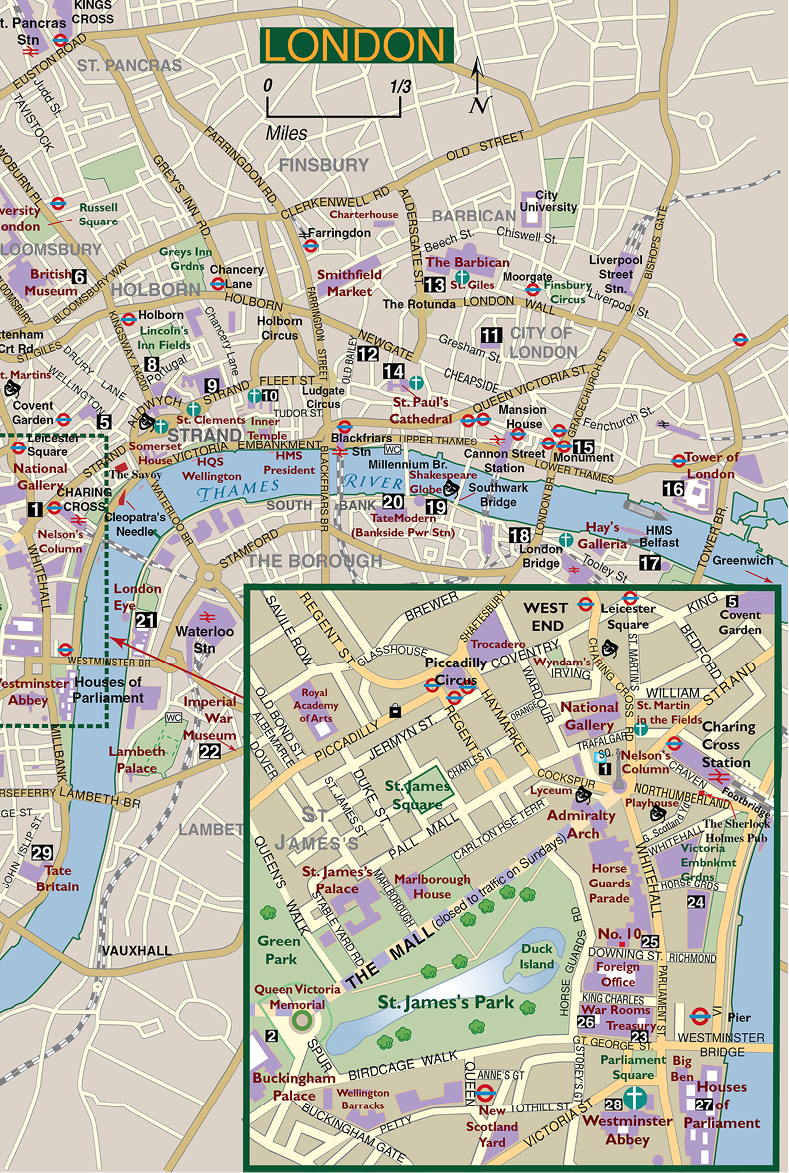
1. Charing Cross – Named for the spot where King Edward I placed a cross in remembrance of his wife Eleanore of Castille, this is considered the geographic centre of London. It marks an important midpoint, where the Strand (leading east to the City) intersects with Whitehall (leading south to Westminster). Charing Cross Underground Station is situated on the southeast side of fountain-filled Trafalgar Square, which is the symbolic heart of London and has become a traditional gathering place for public celebrations of historic events, including V-E Day in 1945 and London’s winning bid in 2005 to host the 2012 Summer Olympics. The square was designed to commemorate Britain’s decisive naval victory at the Battle of Trafalgar in 1805, with Nelson’s Column erected in its centre to honour this national hero who commanded the British fleet. The National Gallery and National Portrait Gallery stand on the square’s north side. To the east is St. Martin’s-in-the Fields church, and on the west side of Trafalgar Square is Canada House, home to the Canadian High Commission in London.
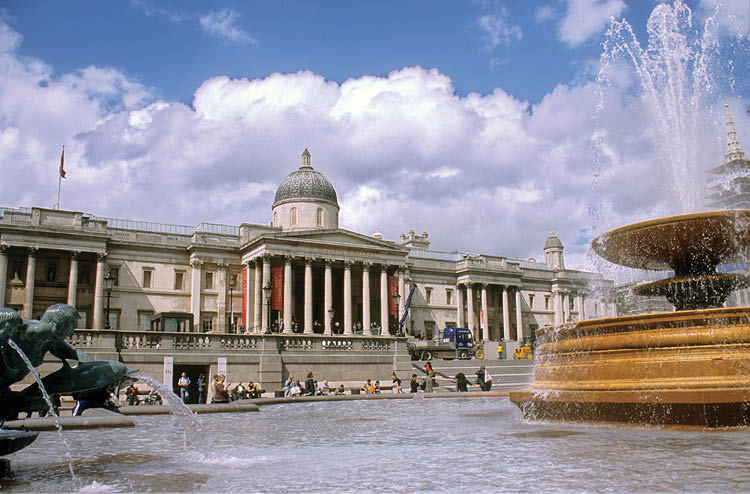
The National Gallery in Trafalgar Square.
The National Gallery houses one of the world’s finest collections of Western European paintings, including Van Gogh’s ‘Sunflowers’ and Turner’s ‘The Fighting Temeraire’. Works by Botticelli, Leonardo da Vinci, Raphael, Titian, Rubens, Rembrandt, Van Dyck, Goya, Constable, Monet and Cezanne are part of the gallery’s permanent collection. An espresso bar, cafe and restaurant are located in the National Gallery, which is open daily from 10:00 a.m. to 6:00 p.m. (to 9:00 p.m. on Wednesdays).
The National Portrait Gallery houses portraits of famous figures in history – royalty, scientists, military leaders, artists, statesmen – from the Middle Ages to the present. It’s open daily from 10:00 a.m. to 6:00 p.m. (until 9:00 p.m. on Fridays and Saturdays). The gallery’s rooftop restaurant provides excellent views and the onsite cafe offers light meals.
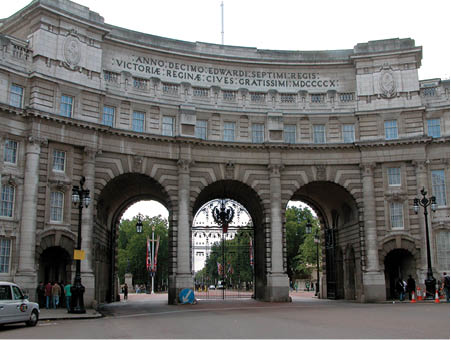
Admirality Arch.
Leading southwest from Trafalgar Square, via Admiralty Arch, is The Mall. This park-lined avenue, which becomes a pedestrian-only mall on Sundays, leads directly to Buckingham Palace. Admiralty Arch, commissioned by Edward VII in memory of his mother Queen Victoria, is actually an office building that incorporates a three-arched passageway built adjacent to the Old Admiralty Building. A curious feature of this landmark is a protrusion resembling a human nose that is situated on the inside wall of the northernmost arch at a height of about seven feet (waist level for a rider on a horse). It symbolized Napoleon’s nose and was to be rubbed by anyone riding through on horseback.
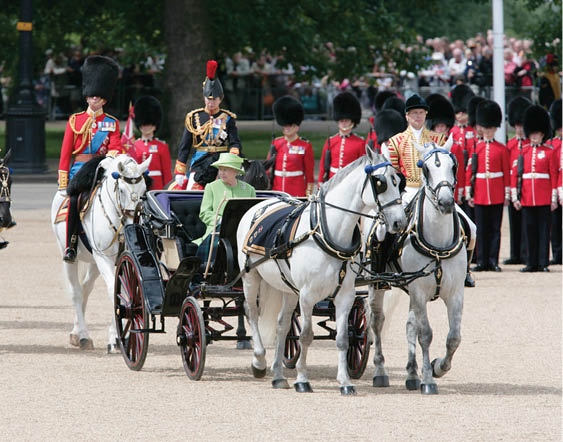
Trooping the Colour for the Queen.
Upon passing through Admiralty Arch into the Mall, you will come upon Horse Guards Road, which leads to the Horse Guards Parade. Once used for jousting tournaments by Henry VIII, this parade ground is now a venue for the daily Changing of the Guard, which takes place at 11:00 a.m. (10:00 a.m. on Sundays) beside the arch of Horse Guards Building. Also held here on the second Saturday in June is the annual Trooping the Colour, the official celebration of the monarch’s birthday. This is a 200-year-old military ceremony in which the ‘colours’ (flags) of the battalion are ‘trooped’ (carried) down the ranks. After inspecting the troops, the Queen rides in a carriage at the head of her guards back to Buckingham Palace where she and other members of the Royal Family gather on the balcony for a fly-past by the Royal Air Force.
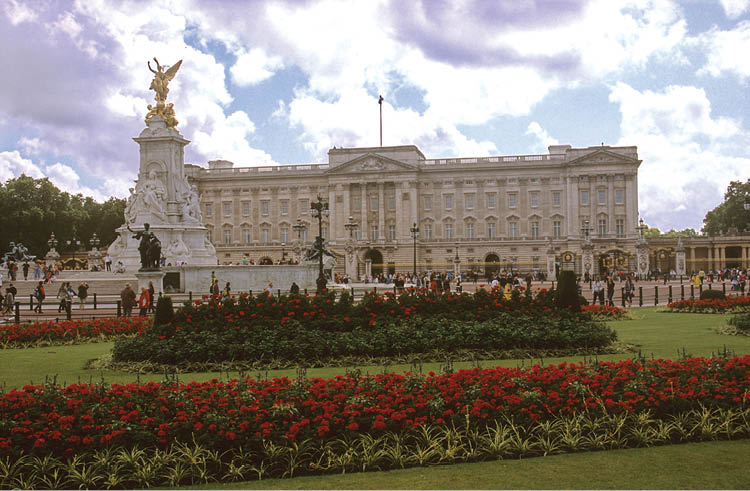
Buckingham Palace remains one of the most iconic sights in central London.
2. Buckingham Palace – The official London residence of Britain’s sovereign and is one of London’s most recognized buildings. Over the decades, millions of people from around the world have watched television footage of the Royal Family waving from the palace balcony during national celebrations while thousands of onlookers filled the Mall and the grounds surrounding the massive Queen Victoria Memorial, which stands in front of the palace gates. Smaller crowds also gather in this area to watch the Changing of the Guard, which takes place in the palace forecourt at 11:30 a.m. daily from May to July (on alternate dates the rest of the year).
When the Queen is in residence, the Royal Standard is flown above Buckingham Palace and four sentries are positioned at the front of the building. When the Queen is elsewhere, the Union Jack is flown and two sentries stand guard. (The Royal Standard is never flown at half mast, not even when a monarch dies, because the heir to the throne immediately becomes the new sovereign.)
Buckingham Palace was built in 1703 by the Duke of Buckingham. Purchased by George III in 1761, the palace was remodeled in 1825 by John Nash, with later additions including the great ballroom where state banquets are held. Queen Victoria was the first monarch to take up residence in Buckingham Palace, in 1837, moving her court here from St. James’s Palace.
Many of Buckingham Palace’s 775 rooms are used for official receptions, while the Queen and members of her family and staff occupy other parts of the palace. About 20 investitures take place each year in the palace ballroom. Recipients of a knighthood (or damehood, its female equivalent) include actors, scientists and industrialists who have made a significant contribution to national life. Non-British citizens are sometimes knighted, such as Bill Gates in 2005.
The State Rooms (open to visitors in August and September) are lavishly furnished and decorated with exquisite porcelain and paintings of the Royal Collection, including those by Rembrandt, Rubens and Vermeer. The ticket office and entrance to the State Rooms is off Buckingham Palace Road, which is where the Queen’s Gallery and Royal Mews are also located. The Queen’s Gallery contains changing exhibits from the Royal Collection of jewellery, paintings and furniture. The Royal Mews is a working stable which houses the horse-drawn carriages used for coronations, royal weddings, the opening of parliament and jubilee celebrations. The walled gardens behind Buckingham Palace are private, but the surrounding Royal Parks are all public.

The Tudor gatehouse at Palace of St. James’s.
St. James’s Park is the oldest and was a swampy meadow when acquired for hunting deer by Henry VIII, who commissioned the Palace of St. James’s. Set within private gardens across the Mall from St. James’s Park, the palace’s original north gatehouse (built in the Tudor style of red brick with polygonal turrets) has survived. When fire destroyed Whitehall Palace in 1698, St. James’s Palace became the monarch’s principal London residence. Built around four courtyards, the palace complex includes Clarence House – the official London residence of Prince Charles and the Duchess of Cornwall. Clarence House is open to the public during summer months, with visitors given a guided tour of the ground floor. The baby Prince George, son of Prince William and the Duchess of Cambridge, was christened October 2013 at Chapel Royal in St. James’s Palace, which is not open to the public and is where the coffin of Diana, Princess of Wales, lay in state in 1997.
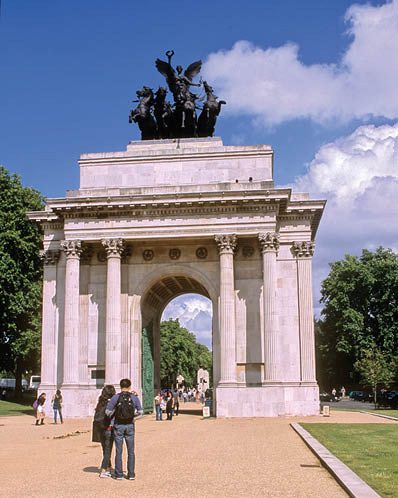
Wellington Arch.
3. Wellington Arch – Green Park, another former deer park, lies along the north side of Buckingham Palace’s gardens and contains the Canada Memorial. Green Park connects with Hyde Park at Hyde Park Corner, site of the Wellington Arch. Built in the 1820s to commemorate Britain’s victories in the Napoleonic Wars, the Wellington Arch is hollow inside and, until 1992, housed a small police station. This is now a museum, which is open to the public, while the other half of the arch is a ventilation shaft for the London Underground. Atop the arch is a massive bronze sculpture depicting the angel of peace descending on a chariot of war.
4. Marble Arch – Designed in 1828 by John Nash and made of white Carrara marble, this arch is based on the triumphal arch of Constantine in Rome. Originally erected on the Mall as a gateway to Buckingham Palace, it now stands at the northeast corner of Hyde Park, where Park Lane intersects with Oxford Street. This is also the location of Speakers’ Corner, where the likes of Karl Marx and George Orwell have engaged in public speeches and debate, a Sunday afternoon tradition. Anyone can voice their opinion – and be heckled – at Speakers’ Corner.

The Italian Fountains in Hyde Park.
Hyde Park is an expansive park containing a man-made lake called the Serpentine and miles of leafy pathways. The park’s monuments include the Albert Memorial, which faces Royal Albert Hall. The Diana Memorial Fountain, designed by American landscape architect Kathryn Gustafson, lies at the west end of Hyde Park in Kensington Gardens. At the far end of Kensington Gardens is Kensington Palace, the former home of Diana, Princess of Wales. Part of the palace is open to the pubic, while the rest contains the private apartments of various Royal Family members, including Prince William and his family.
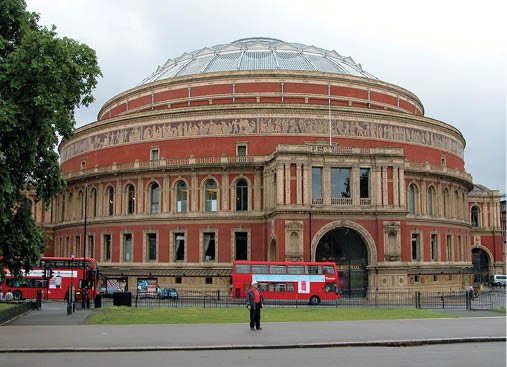
Royal Albert Hall.
Exhibition Road leads south from Kensington Gardens to the Victoria & Albert Museum (exhibiting decorative art), Science Museum and Natural History Museum where the David Attenborough Studio is housed in the Darwin Centre.
Park Lane runs along the east side of Hyde Park and marks the western boundary of the exclusive Mayfair district, developed in the 17th and 18th centuries by the Grosvenor family, whose founder (Gros Veneur) came to England with William the Conqueror. The American Embassy occupies the west side of Grosvenor Square, overlooking public gardens tended by London’s Royal Parks.

Diana Memorial Fountain in Kensington Gardens.
Brook Street leads off the square’s east side to the Handel House Museum (at 25 Brook Street) where the German composer lived in the mid-1700s. The rock musician Jimi Hendrix lived next door from 1968 to 1969.
Also in Mayfair is famous Berkeley Square, well-known from Vera Lyn’s rendition of ‘A Nightingale Sang in Berkeley Square.’ Famous former residents include Winston Churchill who lived as a child at 48 Berkeley Square. Queen Elizabeth II was born on Bruton Street (which leads off Berkeley Square) when her parents were living at the London home of the Strathmores (the Queen Mother’s family). A plaque at 17 Bruton Street commemorates the birthplace of the Queen, who moved as a young girl to Buckingham Palace when her father (George V) became king upon the abdication of his older brother (Edward VIII).
Mayfair’s northern boundary is Oxford Street, a few blocks north of which is The Wallace Collection – a national museum of fine and decorative art. Housed in Hertford House at Manchester Square, this acclaimed collection includes 18th-century French paintings, porcelain and furniture.
Mayfair’s eastern boundary is Regent Street, lined with beaux-art architecture and designed in 1811 by John Nash as a ceremonial route from the regent’s residence in St. James’s Palace to Regent’s Park. This street becomes Portland Place before reaching Regent’s Park and leads past Broadcasting House, a 1930s art deco building which houses the BBC’s headquarters.
5. Covent Garden – The opening scene of George Bernard Shaw’s play Pygmalion (which inspired the musical My Fair Lady) takes place in Covent Garden, where Henry Higgins first meets Eliza Doolittle. The fruit, vegetable and flower market was moved in the mid-1970s to a new location, and the market building is now a shopping mall with cafes and a public square. Alfred Hitchcock was the son of a Covent Garden merchant, and supermodel Naomi Campbell was discovered by a model scout while strolling through Covent Garden at the age of 15.
London Transport Museum is located in Covent Garden Piazza and features interactive displays on London’s Underground – the world’s oldest underground network of railway tunnels, which opened in 1863 with steam-powered trains, followed by electric trains in 1890. The Royal Opera House is located at Covent Garden and is where the British ballerina Margo Fonteyn performed with Rudolf Nureyev in the 1960s.
Soho is a Bohemian district associated with rock music and counter-culture. Carnaby Street was a popular hangout during the ‘Swinging Sixties’ and is still a busy shopping street. Denmark Street, filled with music shops and recording studios, is where the Beatles, Rolling Stones and Jimi Hendrix all recorded music.
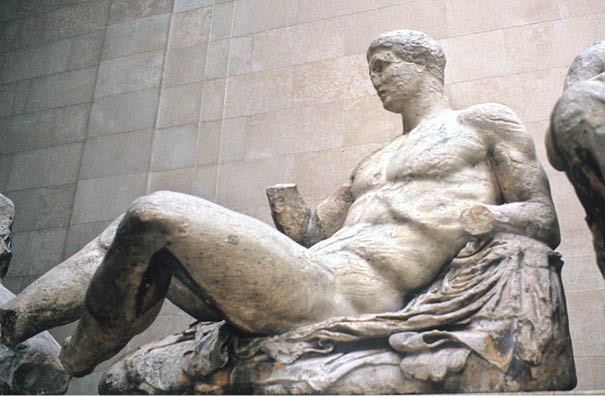
The Elgin Marbles are displayed at the British Museum.
6. British Museum – Bloomsbury is known for the many writers, including Virginia Woolf, who lived in this part of London in the 1930s. The Great Ormond Street Hospital, founded in 1852 to care for sick children, is also located in Bloomsbury and was granted the copyright to Peter Pan in 1927 by the playwright J. M. Barrie. Bloomsbury is best known as the location of the British Museum – one of London’s most famous attractions. Among its vast collections are such ancient treasures as the Rosetta Stone (engraved with Egyptian hieroglyphics) and the Elgin Marbles (taken from the Parthenon in Athens) as well as rare manuscripts, including Beowulf and Magna Carta.
The British Museum was established by the government in 1753 upon acquiring several private collections of priceless manuscripts and other antiquities. Its first location was Montagu House, but when larger quarters were needed, construction began on its current building in the 1820s. Britain’s national library occupied its sprawling inner courtyard until the massive British Library near St. Pancras train station on Euston Road was completed in 1973. The Museum’s transformed courtyard was unveiled in 2000 as the Queen Elizabeth II Great Court, its domed Reading Room restored to its Victorian splendour and newly added facilities including galleries, shops and a café and restaurant. (www.thebritishmuseum.ac.uk)
Regent’s Park is a former hunting ground of King Henry VIII. This sprawling park covers 410 acres (166 hectares) and contains rose gardens as well as London’s largest sports area with a pavilion and various pitches.
7. London Zoo – Designed in 1811 by John Nash, located in Regent’s Park, this zoo was once home to a famous bear named Winnie (short for Winnipeg). She was brought to England during the First World War as a mascot for a militia cavalry regiment of the Canadian army and was donated to the zoo by her owner, Lieut. Harry Colebourne, before he headed to France for active duty. Winnie entertained children and adults alike with her playful nature, prompting a little boy named Christopher Robin to name his stuffed teddy bear ‘Winnie’, and inspiring the boy’s father, A. A. Milne, to write his children’s classics about Winnie the Pooh.
At the northwest end of Regent’s Park lies the posh residential district of St. John’s where the Abbey Road Studios are located. The Beatles recorded most of their music here, including their Abbey Road album, its cover photograph featuring the four band members crossing Abbey Road.
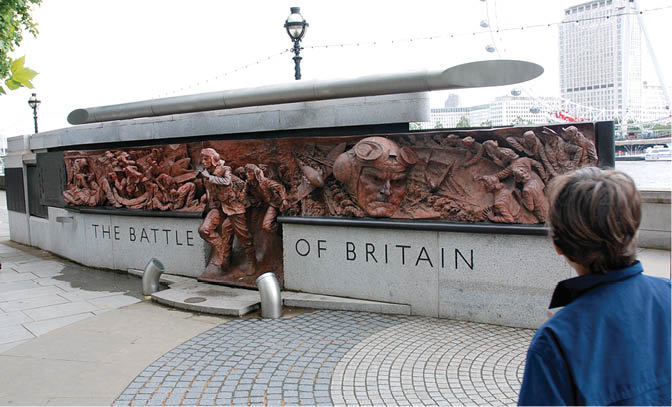
The Battle of Britain war monument on the Embankment.
Leading east from Trafalgar Square into the City is the Strand, which traced the river bank before the Victoria Embankment was built in the 1860s to provide London with a modern sewage system. Points of interest along the Victoria Embankment include the Battle of Britain War Monument – a long, granite structure unveiled in 2005 by Prince Charles. Its design incorporates an existing smoke outlet once used for steam-powered underground trains. The monument honours the airmen who fought in this famous WWII battle and of whom Winston Churchill said, “Never in the field of human conflict was so much owed by so many to so few.”
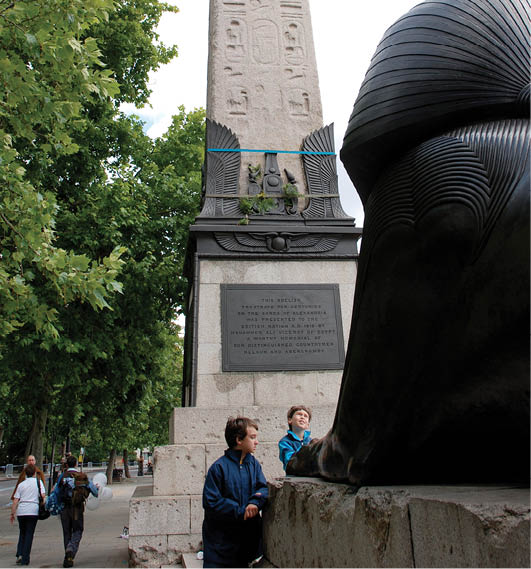
Cleopatra’s Needle on Victoria’s Embankment.
Another landmark along Victoria Embankment is Cleopatra’s Needle – an ancient Egyptian obelisk cut from red granite which was quarried at Aswan on the Nile River in about 1450 BC. It was presented by the Egyptian government to the United Kingdom as a diplomatic gift in 1819 and was erected on the Victoria Embankment in September 1878.
The Savoy, Britain’s first luxury hotel, opened in 1899 on the Strand, overlooking a sweep of the River Thames – a view painted by Claude Monet while staying in a fifth-floor suite. Bob Dylan filmed Subterranean Homesick Blues in a nearby alley while staying at the Savoy in 1965.
Somerset House stands on the south side of the Strand, just east of Waterloo Bridge. The original structure was replaced in the late 1700s with a neoclassical building (its Victorian wings later added). Built to house the Admiralty, Somerset House is now home to the Courtauld Gallery’s important collection of old master and impressionist art.
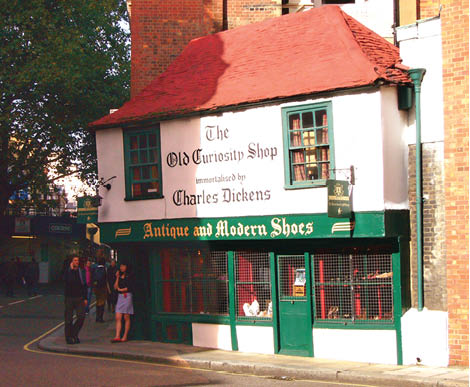
The Old Curiosity Shop.
8. The Old Curiosity Shop – Located on Portsmouth Street, this shop was built in 1567 of old ships’ timber and is believed to be the inspiration for Charles Dickens’s classic novel of the same name.
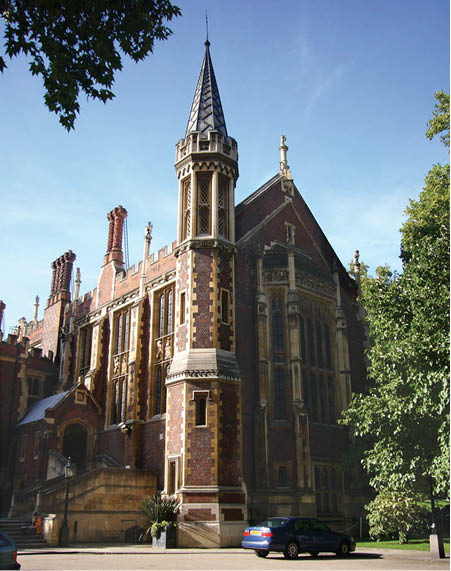
Lincoln’s Inn.
9. Royal Courts of Justice – An imposing Victorian Gothic building located on the north side of the Strand, just outside the entrance to the City. In the vicinity of the Royal Courts of Justice are the four Inns of Court – Gray’s Inn, Lincoln’s Inn, Inner Temple and Middle Temple. All barristers in England belong to one of these law societies, and each inn is a complex of buildings, which includes offices, libraries, dining facilities, accommodation and a church or chapel.
10. Temple – The famous Order of Knights Templar established an English seat in London in the 12th century, building the Temple hall, library and church – the latter a private chapel for lawyers of the two Temples. A round Norman church, it was restored following severe fire damage during the Blitz and gained a high profile when featured in Dan Brown’s novel The Da Vinci Code.
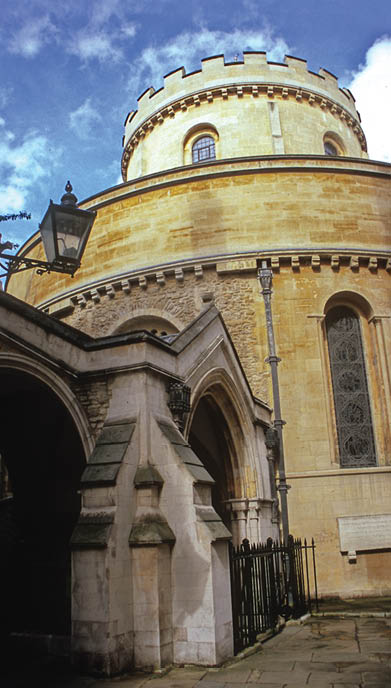
Temple Church is well worth going inside to contemplate past crusades.
The City, London’s historic core and location of the London Stock Exchange, Lloyds of London and the Bank of England, is entered from the west at Temple Bar – a stone monument standing in the middle of the road where the Strand becomes Fleet Street.
11. Guildhall – Constructed in the 1400s when the Lord Mayor rivalled the monarch for influence and held court here with the City’s wealthy merchants. Its high-ceilinged great hall is still used for glittering banquets.
12. Old Bailey Criminal Court – This criminal court (well known to fans of John Mortimer’s Rumpole of the Old Bailey) is located on Old Bailey Road.
13. The Museum of London – Located a few blocks north of St. Paul’s Cathedral, along St. Martins-le-Grand, this museum contains prehistoric, Roman and medieval galleries.
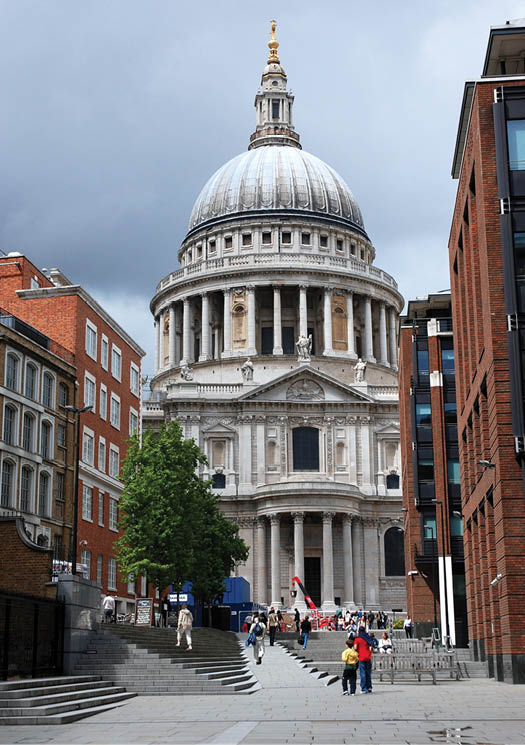
Approaching St. Paul’s from the Millennium Bridge.
14. St. Paul’s Cathedral – One of England’s finest churches, this cathedral stands at the head of Ludgate Hill where a Roman temple once stood. When the great fire of London (1666) damaged the church at this site, Christopher Wren was commissioned to design a new one. He laid the first foundation block in 1675, and 35 years later his baroque masterpiece was completed.
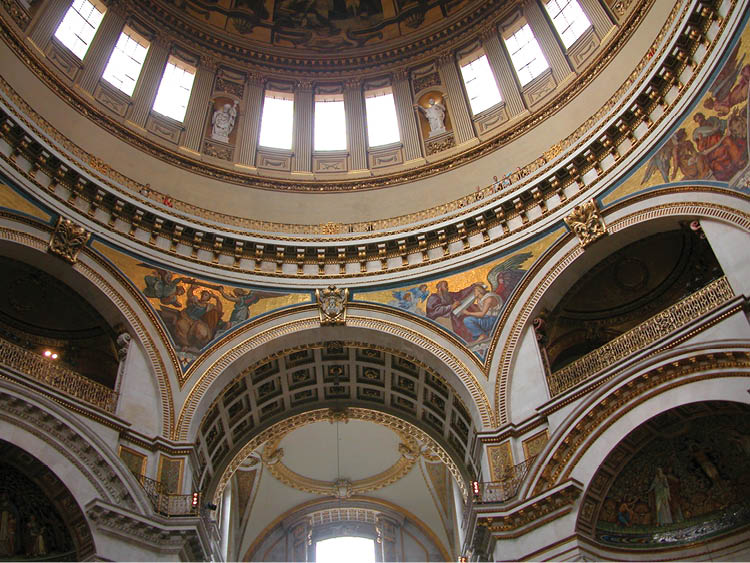
The domed interior of St. Paul’s.
The dome, one of the largest in the world, is magnificent. Its interior is decorated with paintings of biblical scenes and is ringed by the Whispering Gallery, which can be reached by climbing up 163 stone steps. Another 119 steps will get you to the Stone Gallery, on the outside of the dome, and 152 steps further up is the Golden Gallery with panoramic views across London.
In the basement of the cathedral is a crypt containing the tombs of Admiral Lord Nelson, the Duke of Wellington, Sir Christopher Wren, Florence Nightingale and Sir Henry Moore. (A cafeteria, gift shop and toilets are also located on this lower level.)
Although royal weddings are traditionally held in Westminster Abbey, the wedding of Prince Charles and Lady Diana Spencer was held at St. Paul’s in 1981 because the cathedral was large enough to accommodate all of the invited guests. Admission is charged to St. Paul’s Cathedral.
15. The Monument – Located east of St. Paul’s, near the north end of London Bridge. A stone column over 200 feet tall (311 stairs to the top), it stands near the spot where the Great Fire of London started in a baker’s shop on Pudding Lane.
16. The Tower of London – One of London’s most famous landmarks, this tower was built as a medieval fortress and royal castle. Most people think of it first and foremost as a prison for queens and courtiers, princes and priests, many of whom spent their final days within the Tower’s walls awaiting execution. Declared a World Heritage site in 1988, the Tower of London draws visitors by the millions, who come to view the Crown Jewels on display in the Waterloo Barracks or to pause beside Tower Green and ponder the final minutes of the lives of Anne Boleyn, Katherine Howard and Lady Jane Grey before they were beheaded.
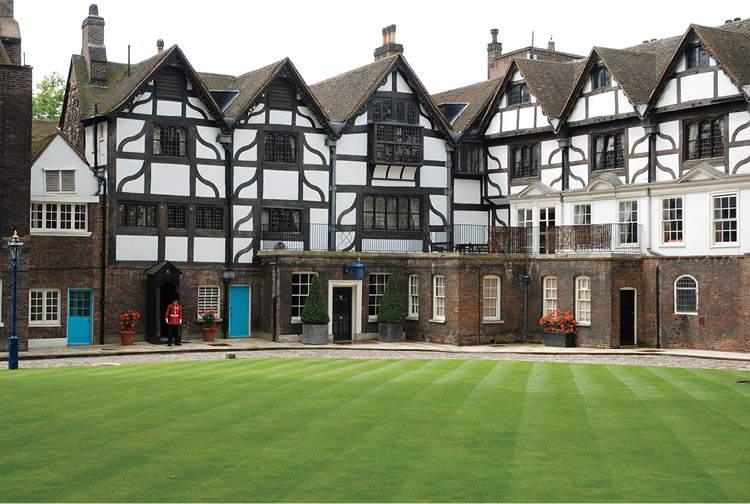
Tower Green.
The Tower was built to assert royal authority over London and, in times of unrest, to provide safe haven for a monarch escaping an angry mob. There were no dungeons in the Tower, and prisoners – most of whom were from the upper classes – were treated according to their social rank. When Anne Boleyn was brought to the Tower to await execution, she was taken to the same lodging she had slept in while awaiting her coronation. The Tower was a busy place during the reign of Henry VIII, who ordered the beheading of two queens, a lord chancellor, an archbishop and numerous others who challenged his kingship.
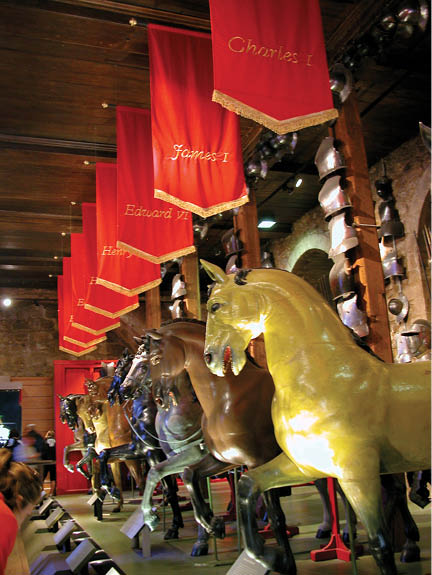
Royal regalia on display in the White Tower’s Great Hall.
Ghosts are said to inhabit the Tower of London, but the 35 Yeoman Warders who work and live with their families within the Tower walls (about 150 residents in total) aren’t too bothered. Those with flats in the Beauchamp Tower, overlooking Tower Green, don’t mind that their ‘village green’ used to have a scaffold on it, or that their local church – the Chapel Royal of St Peter ad Vincula – is the burial place of three English queens and two Roman Catholic saints (Thomas More and John Fisher). The Yeoman Warders have a local pub like any other community and after school the resident children can be heard playing outside.
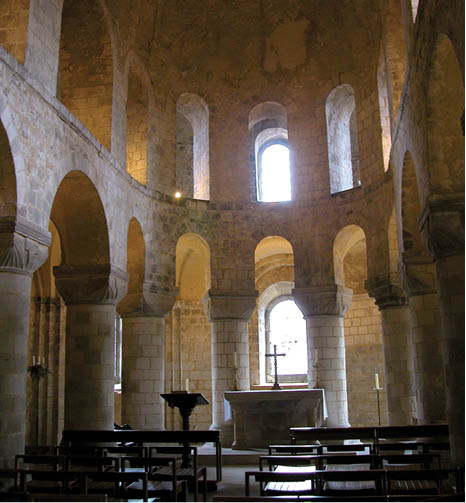
St. John’s chapel.
A menagerie of animals once lived within the Tower grounds, but today there are only six ravens who sleep in cages outside the White Tower but who roam freely during the day. It was Charles II who decreed there must always be six ravens living at the Tower or the Kingdom of England would fall. To prevent the ravens from flying away, their feathers are trimmed.

The White Tower.
The White Tower is the original Tower building, its construction begun by William the Conqueror in about 1070 (the walls were painted white in 1240 to make the citadel more imposing). St John’s Chapel (one of England’s most complete examples of early Anglo-Norman ecclesiastical architecture) occupies the White Tower’s first floor, as does a Great Hall now used to display 16th-century armour and weaponry, including equipment made for Henry VIII.

Waterloo Barracks.
In 1674, the skeletons of two boys (aged about 10 and 12 years) were found hidden under a staircase leading to the Chapel of St. John. These presumably were the remains of Edward IV’s two young sons, who were ordered to the Tower in 1483 by their uncle upon their father’s death. When the two princes mysteriously disappeared and their uncle was crowned Richard III, it was widely believed that he had ordered the boys murdered.
Admission is charged at the Tower of London, and tickets can be bought in advance online (365tickets.com).
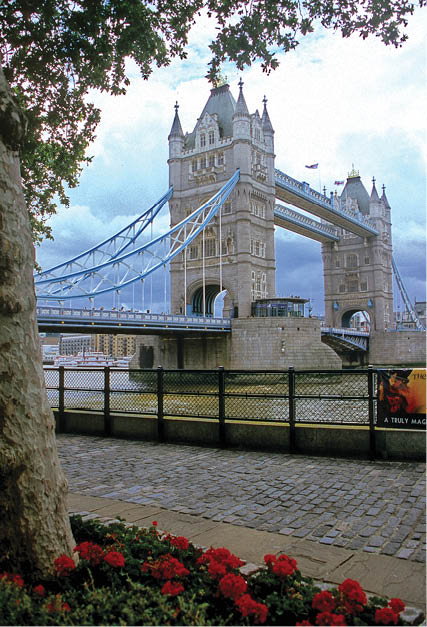
Tower Bridge.
Tower Bridge, constructed in the late 1800s, crosses the Thames opposite the Tower of London. It was designed as a combination suspension and bascule (moveable) bridge so that large vessels can access the port facilities in the Pool of London, which lies between the Tower of London and London Bridge. The bridge’s high-level walkway is part of the Tower Bridge Exhibition, housed in the bridge’s twin towers.
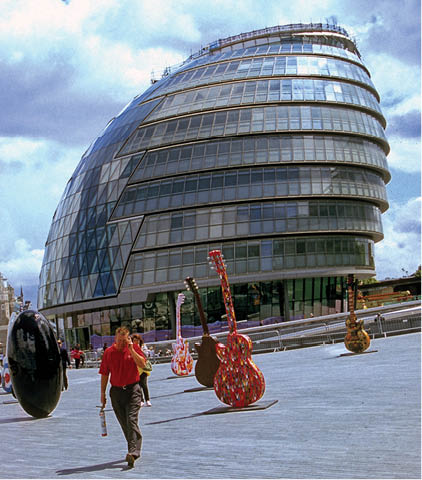
London’s City Hall.
17. City Hall – The south bank of the Thames opposite the City is where the Globe Theatre and Tate Modern are located. A riverside pedestrian promenade leads from Tower Bridge past Greater London’s new City Hall (a modern glass structure shaped like a beehive) and the permanently moored HMS Belfast, a WWII Royal Navy cruiser which is maintained by the Imperial War Museum and serves as London’s Floating Naval Museum. Nearby is Hay’s Galleria, a converted wharf now housing shops and a riverside pub. Nearby, located next to London Bridge Station, is The Shard – a skyscraper designed by Renzo Piano which contains offices, the Shangri-La hotel and a viewing gallery on its top floors.
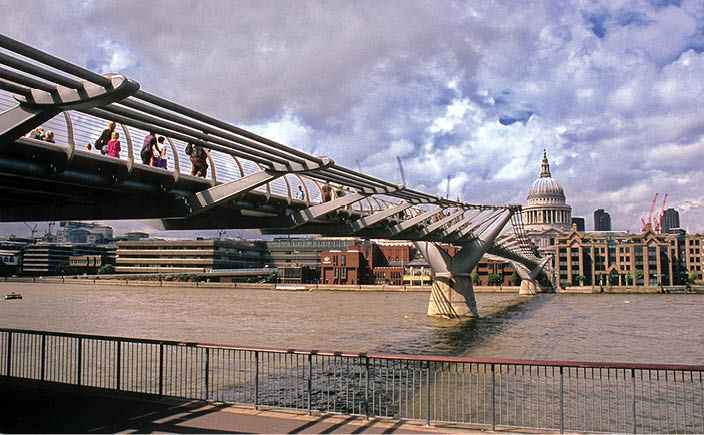
Millennium Bridge.
18. Southwark Cathedral – London Bridge marks the eastern edge of Bankside, once a seedy area of dockyards, taverns and brothels. Attractions here include Southwark Cathedral, the oldest Gothic church in London, its main structure built between 1220 and 1420. William Shakespeare’s actor brother was buried here in 1607. Moored in a nearby quay is a replica of Francis Drake’s warship the Golden Hinde. Close by is the historic Anchor Pub where Samuel Pepys watched the Great Fire of London burning across the river in 1666 and where Dr. Johnson was a regular with a room reserved here in which to write.
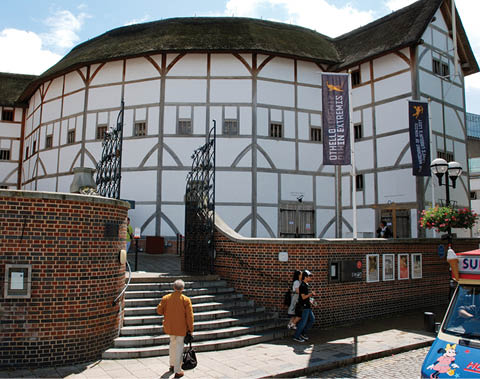
Shakespeare Globe Theatre.
19. Shakespeare Globe Museum & Theatre – Located West of Southwark Bridge, this open-air theatre is a reconstruction of the round-shaped Elizabethan theatre where Shakespeare’s plays were first performed. The original theatre burned down in 1613 when a theatrical cannon misfired during a performance of Henry VIII and set the thatch roof ablaze. No one was hurt, but one man had to douse his burning breeches with a bottle of ale. In Shakespeare’s time, Bankside was a cesspool of taverns, bawdy-houses, gambling joints and bear-baiting rings, with church sermons warning about the evils of the theatre.
Sam Wanamaker, an American actor and filmmaker, campaigned for years to have the new Globe built within a few hundred yards of its original site and work finally began in 1987. Ten years later, Queen Elizabeth II arrived by royal barge to officially open the Globe Theatre. In 2014 the Sam Wanamaker Playhouse (a new addition) opened adjacent to the Globe Theatre and Shakespeare’s plays (along with tours) are now staged year-round.
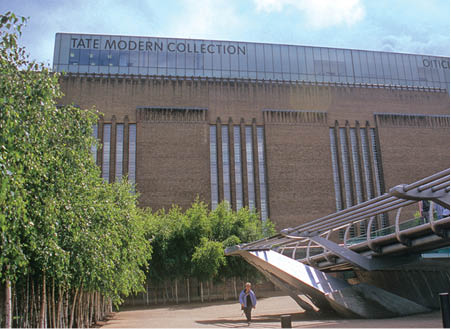
Tate Modern.
20. Tate Modern – Located west of the Globe Theatre, this public art gallery features international modern and contemporary art, including works by Picasso, Matisse and Dali. Housed in a converted power station, Tate Modern opened in 2000. Its massive Turbine Hall is five storeys high and a restaurant is located on the top floor overlooking the Thames where the Millennium Bridge – a footbridge that opened in 2000 – crosses the river to St. Paul’s Cathedral.
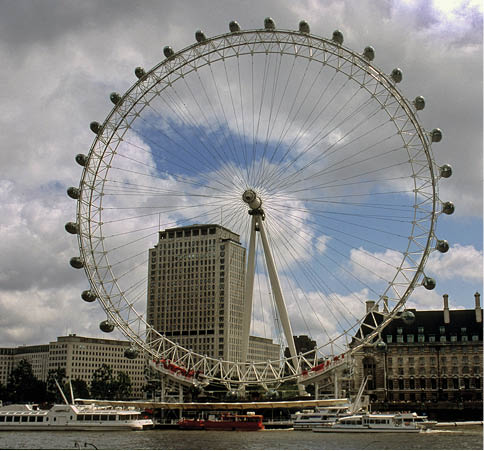
The London Eye.
21. The London Eye – A London icon since its completion in 2000, this gigantic, cantilevered wheel holds 32 passenger-observation capsules from which you can enjoy fabulous views of London. It moves very slowly, allowing time to identify and photograph famous landmarks, such as the Houses of Parliament and Buckingham Palace. Tickets can be booked in advance online and the ride lasts about thirty minutes.
22. The Imperial War Museum – Located on Lambeth Road, this museum is housed in a former psychiatric hospital called Bedlam. The museum’s six floors house a vast treasury of galleries, displays and collections that catalogue modern-day conflicts, from World War I to the present. In addition to hundreds of war paintings, archival photographs and private letters, large exhibits include the command tank of Field Marshall Montgomery.
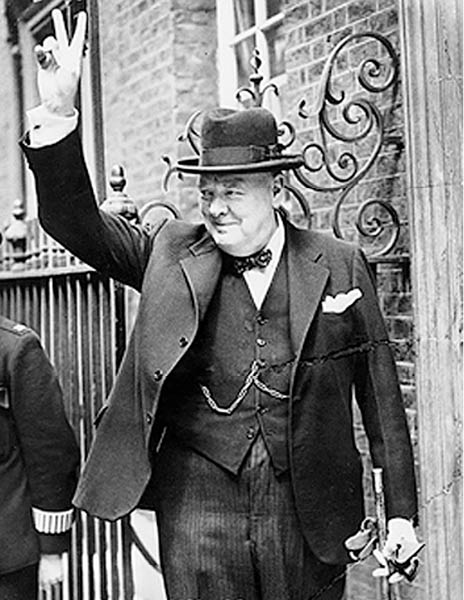
Churchill waves the victory sign outside No. 10 Downing Street.
23. Treasury – Whitehall, which leads south from Trafalgar Square, is lined with government buildings, including the Treasury, with its rooftop providing a vantage for Prime Minister Churchill to watch enemy bombers attacking London during World War II. Whitehall was once a wide road that led to the Palace of Whitehall, a Tudor palace that was destroyed by fire in 1698.
24. The Banqueting House – An addition to the palace designed by Inigo Jones in 1622, this house survived the fire and is today open for public viewing. The two-storey banqueting hall within the house is a splendid example of the Italianate Renaissance style studied by Jones in Italy, with its bays of windows, Ionic pilasters and a ceiling painted by Rubens. Charles I was executed here, outside a first-floor window, from which he stepped onto a scaffold.
Sidestreets leading off Whitehall include Scotland Yard, the former site of a 12th-century palace used by visiting Scottish kings and where the Criminal Investigation headquarters of the London Metropolitan Police was located before relocating to New Scotland Yard on the Victoria Embankment in 1890.
25. Downing Street – Another Whitehall side street, where Number 10 is the residence and office of the Prime Minister of the United Kingdom. Originally three houses, they were joined together in 1732 to create a building large enough to accommodate the headquarters of Her Majesty’s Government, including offices, meeting rooms and dining rooms, in addition to the private living quarters of the Prime Minister and his family. The public is no longer allowed access to Downing Street, which is blocked at each end with iron gates (installed in the 1980s) and retractable electronic barriers (installed in the 1990s).
26. Churchill Museum and Cabinet War Rooms – During World War II, German air raids forced Prime Minister Winston Churchill and his government to seek shelter underground. A bunker located under King Charles Street (one block south of Downing Street) was used and some of these rooms have been preserved as a museum called the Churchill Museum and Cabinet War Rooms. Here visitors can view the map room, cabinet meeting room and Churchill’s office-bedroom containing the desk and BBC microphones with which he made his world broadcasts. The trans-Atlantic telephone room (a converted broom closet) is where Churchill placed his top-security phone calls to President Roosevelt. A cable connected Churchill’s phone to a large computer-sized scrambler (developed by American Bell Telephone Laboratories) located in the basement of Selfridges department store on Oxford Street. Partially enciphered messages from Churchill’s phone were fully enciphered by the scrambler and sent by radio waves to the President in Washington.
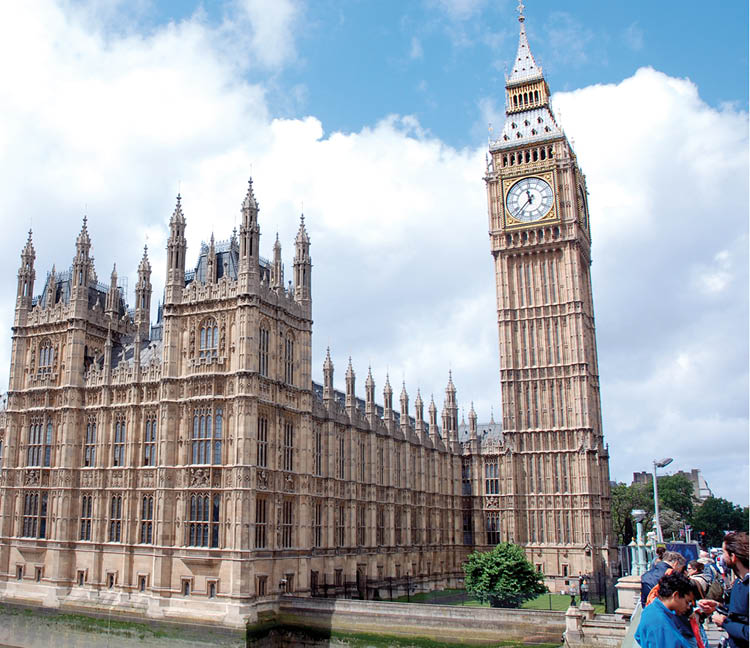
Palace of Westminster.
27. Palace of Westminster – South of Westminster Bridge, overlooking the River Thames, is one of London’s most famous landmarks – the Palace of Westminster, built in the mid-1800s to house the British Houses of Parliament. This famous neo-Gothic palace took 30 years to build at a cost of over £2 million (£1.3 million over budget) and took its toll on the architect Charles Barry and his assistant August Welby Pugin, both of whom literally worked themselves to death overseeing every detail. Neither lived to see their creation completed, but they left behind a national monument recognized the world over as a symbol of democracy and home to one of the most ancient of parliamentary monarchies. The immense complex contains nearly 1,200 rooms, 100 staircases and over two miles of passages.
The medieval palace that once occupied this site was a royal residence for several centuries, until a fire in 1512 prompted Henry VIII to move to nearby Whitehall Palace, leaving the Palace of Westminster to become, over time, a parliamentary building. A devastating fire destroyed most of the Palace in 1834, and the current structure – still called Westminster Palace – now stands on this site.
Westminster Palace’s north tower – the Clock Tower – was renamed the Elizabeth Tower in 2012 in honour of Queen Elizabeth II and contains the huge bell nicknamed Big Ben. The palace’s west side is where the medieval Westminster Hall has stood since 1099, its magnificent hammerbeam roof rebuilt in the 1300s. Westminster Hall was used for royal feasts, coronation banquets and notable state trials (Charles I was condemned to death here). The hall survived the 1834 fire (which destroyed the rest of the palace) and the 1941 bombing that devastated the Commons Chamber, and is used for major public ceremonies and the lying in state of monarchs, consorts and, occasionally, distinguished statesmen such as Sir Winston Churchill.
St. Stephens Entrance – the public entrance to the Palace of Westminster – is at the southern end of Westminster Hall. The House of Commons occupies the north part of the palace and the House of Lords is in the south part. Both visitor galleries are open to the public when the Houses are in session. Overseas visitors can queue outside St. Stephen’s Entrance to obtain entry (only UK residents can obtain free tickets in advance to ensure entrance). Tours are held during the Summer Opening (early August to early October) and tickets can be bought in advance online or on the day at the Ticket Office (located next to the Jewel Tower). Visit www.parliament.uk for more information.

Westminster Abbey
28. Westminster Abbey – Located across the street from the Houses of Parliament, Westminister Abbey is where nearly every English king and queen has been crowned since the 11th century, including Queen Elizabeth II’s coronation in 1953. A magnificent Gothic structure with tiered arches, fan vaulting and rich carving, Westminster Abbey is also a national shrine, containing the tombs of 18 monarchs, including half-sisters Queen Elizabeth I and Queen Mary I. Distinguished subjects are also buried in the Abbey, and Poets’ Corner contains the tombs of Chaucer, Browning, Tennyson and other great poets. Royal weddings and funerals are held in the Abbey, which dates to the 13th century when construction began to replace the site’s original Benedictine abbey. Next door to the Abbey is the medieval church of St. Margaret’s, first built in the late 11th century by Benedictine monks and today the parish church for the Houses of Parliament. Winston Churchill and Clementine Hozier were married in this church in 1908.
29. Tate Britain – Located South of Westminster, overlooking the Thames at Millbank, is the Tate Britain, founded in 1897 by sugar magnate Sir Henry Tate, who owned the patent for making sugar cubes and quietly donated much of his personal fortune to charitable causes, including construction of the Tate Gallery. Historic and contemporary art is exhibited at the Tate Britain, including works by Turner, Gainsborough, Constable, James McNeill Whistler and Henry Moore.
Upriver from Millbank is Chelsea – an upscale district of exclusive residential squares which was an enclave of 19th-century artists and the heart of the Pre-Raphaelite movement. Famous former residents include Oscar Wilde (34 Tite Street), James Abbott McNeill Whistler (96 Cheyne Walk) and Mark Twain (23 Tedworth Square). The famous Chelsea Flower Show, held each May by the Royal Horticultural Society on the grounds of the Royal Hospital (a retirement and nursing home for military veterans), is always attended by the Queen. During the ‘Swinging Sixties,’ members of the Beatles and the Rolling Stones lived on King’s Road, which intersects with Sloane Street at fashionable Sloane Square.
Chelsea Bridge, a self-anchored suspension bridge, crosses from Chelsea to Battersea Park on the south bank of the River Thames. During the Queen’s Diamond Jubilee celebrations in 2012, crowds thronged here to watch Her Majesty’s royal barge and accompanying flotilla of boats sail down the River Thames.
Hampton Court Palace lies upriver from London and can be reached by train from Waterloo Station or by riverboat from Westminster Pier. Originally built as a country home for Cardinal Wolsey, Hampton Court became Henry VIII’s favourite residence and much of this Tudor palace has survived, including the Great Hall, Chapel Royal and Haunted Gallery. Baroque updates to the palace were made by Christopher Wren. The palace grounds run down to the River Thames where visitors can enjoy picnics amid the fountains and gardens.
Kew Palace and the famous Kew Gardens are located along the River Thames in Richmond and can be reached by riverboat from Westminster Pier. One of the world’s leading botanic gardens, Kew is a UNESCO World Heritage Site containing extensive gardens and greenhouses. Kew Palace, a red-brick mansion built in 1631, was the family home of George III (the ‘mad’ king) who lived here with Queen Charlotte and some of their 15 children.

National Maritime Museum.
Greenwich, located six miles downriver of the Tower and accessible by river boat, is a World Heritage Site and home to the National Maritime Museum and the tea clipper Cutty Sark. Greenwich Mean Time was (until 1954) based on observations at Greenwich’s Royal Observatory. Greenwich is the birthplace of Henry VIII and Elizabeth I, and a Tudor palace once stood on the site of the Old Royal Naval College – a baroque masterpiece designed by Christopher Wren. Nearby, on the Greenwich Peninsula, is the O2 arena and Emirates Air Line cable car spanning the River Thames between North Greenwich and the Royal Docks in Newham. A new cruise terminal is slated to open in 2016 at Greenwich’s Enderby Wharf.
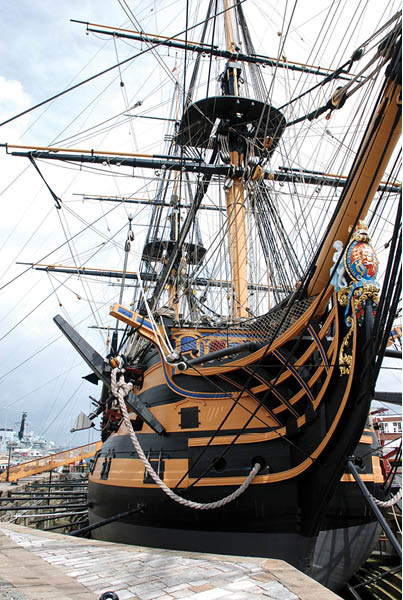
HMS Victory.
Passengers beginning or ending their cruise in England should consider spending not only a few days in London, but also touring the south of England by train or rental car to see places such as Bath (famous for its Roman baths), Stratford-upon-Avon (birthplace of William Shakespeare), Oxford (the steepled university town and locale of the Inspector Morse mysteries) and Blenheim Palace – a masterpiece of English baroque architecture and the birthplace of Winston Churchill. Situated beside the medieval town of Woodstock, Blenheim Palace stands on the site of a former royal palace and was built for John Churchill, Duke of Marlborough, as a reward from the Crown for his military victory at Blenheim in Bavaria. The palace, set in miles of landscaped park, is a World Heritage Site.
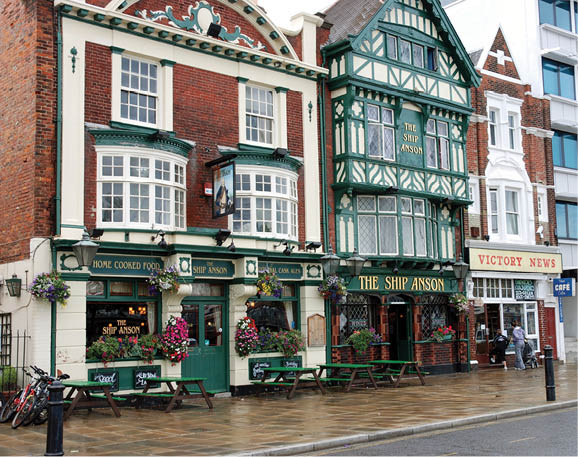
A Portsmouth street.
Places of interest near the port of Southampton include Winchester (12 miles away), with its famous Gothic cathedral. Further afield (34 miles distant) is Stonehenge (see page 42), for which tickets can be pre-booked online; visitors are taken to the site via a short shuttle ride from the new welcome centre). The naval port of Portsmouth (25 miles west of Southampton) is located on Portsea Island and is a base port for small cruise ships. Soaring above the city’s revitalized waterfront at Gunwharf Quays is the Spinnaker Tower, providing breathtaking views for miles in every direction. Charles Dickens was born in Portsmouth (his family’s modest house now a museum) but the city’s main attraction is the Historic Dockyard, where visitors can step aboard Nelson’s flagship Victory and view a Tudor-era warship at the Mary Rose Museum.
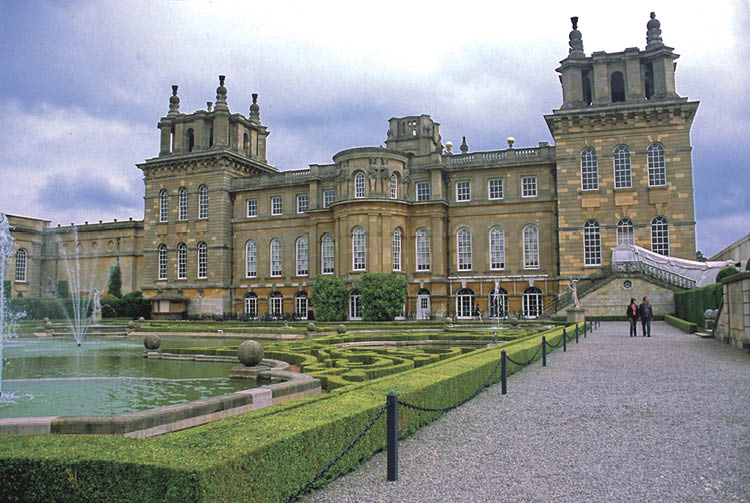
Blenheim Palace.
Should your cruise depart from Dover, it’s worth spending an extra day or two in the Kentish countryside visiting a few castles, gardens and magnificent Canterbury Cathedral. Right in Dover, overlooking the port, is Dover Castle – atop the famous white cliffs of Dover Naturally cleaned by rainfall (which also erodes the white-coloured chalk) these cliffs are managed by the National Trust and a visitor centre at Langdon Cliffs provides information about the cliff-top hiking trails.
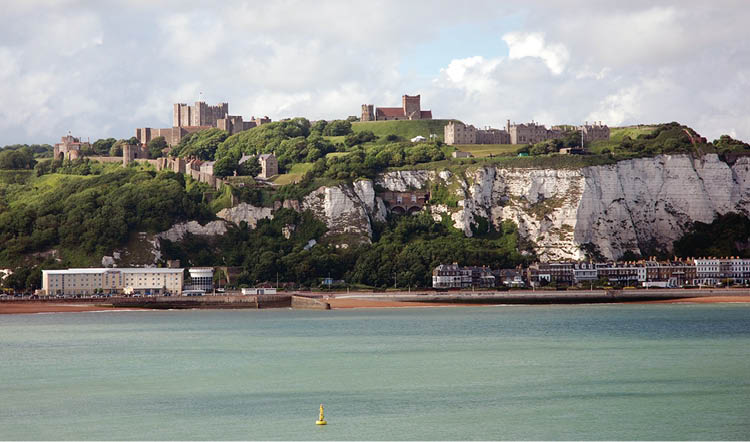
Dover Castle.
Standing guard atop the white cliffs is Dover Castle. No fortress in England has a longer history than Dover Castle, its initial construction begun by William the Conqueror in 1066. Overlooking the shortest sea crossing to France, the castle was designed to defend England from invasion. Hidden beneath Dover Castle is a labyrinth of dark, medieval tunnels, used as recently as World War II when the castle was a military headquarters with wartime personnel working and sleeping underground. A chain of fortresses was built along this coast during Henry VIII’s reign, and these include nearby Deal Castle (one of the finest Tudor artillery castles in England) and Walmer Castle and Gardens, linked to Deal by a beachfront cycle path. All of these castles are managed by English Heritage and are open daily, April to October.
Map of Dover
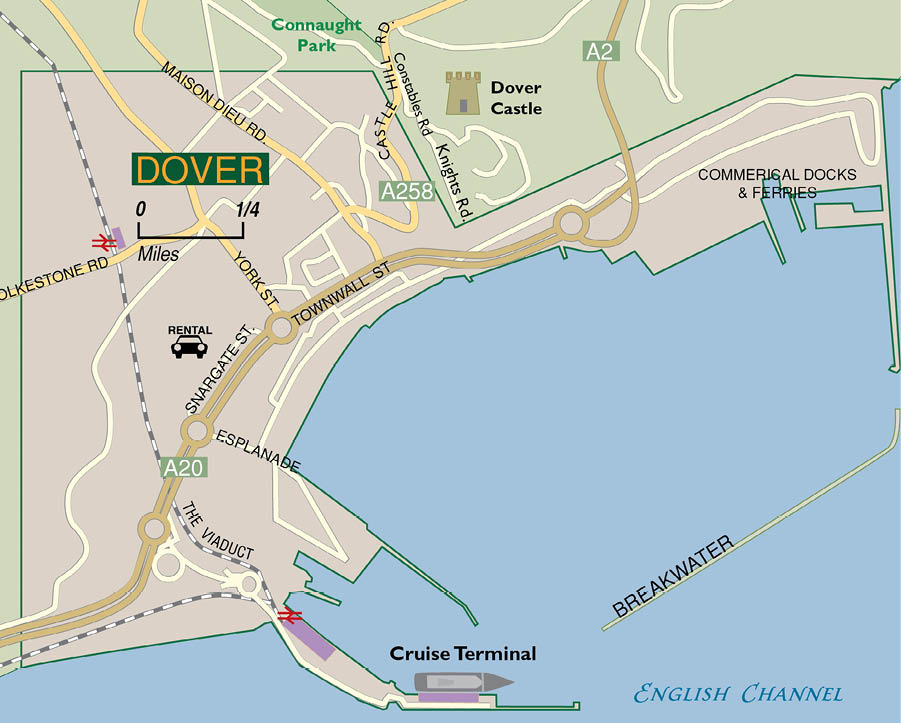
Also close to Dover (about 15 miles north) is the cathedral town of Canterbury. Remains of its medieval walls still stand, within which is a warren of winding streets that lead to Canterbury Cathedral – a magnificent structure built over several centuries, starting in 1070. The cathedral stands on the site where an abbey was built by St. Augustine in 597 when he arrived from Rome to convert England to Christianity. In 1170, several of King Henry II’s knights entered the cathedral and murdered Thomas Becket, whose shocking martyrdom made Canterbury famous throughout Europe as a place of pilgrimage. A stone slab in the northwestern transept marks the exact spot of St. Thomas’s slaying. The marble chair in which archbishops are enthroned stands in the east chapel. The cathedral’s long and storied history is reflected in various architectural styles, including the splendid nave, which was rebuilt from 1377 to 1405 in the Perpendicular Gothic style.
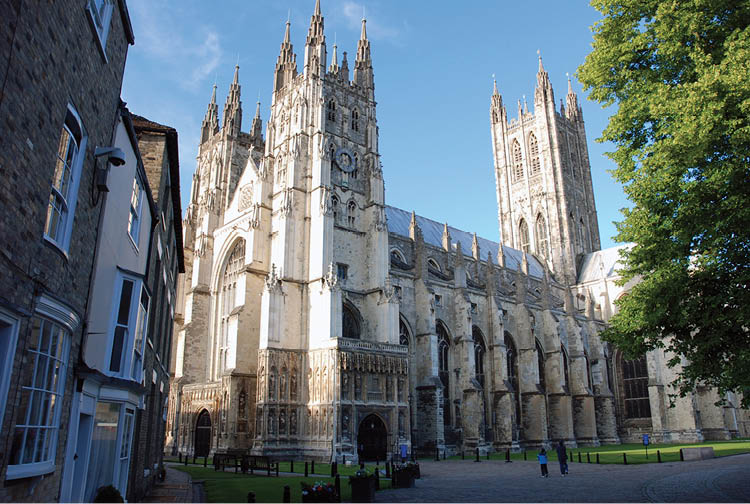
Canterbury Cathedral
Five miles from Canterbury is Goodnestone Park Gardens, fifteen acres of resplendent gardens showcasing a stately manor home built in 1704. Jane Austen’s brother married a daughter of the estate’s third baronet, and the famous author was a regular visitor who found inspiration here for her novel Pride & Prejudice.
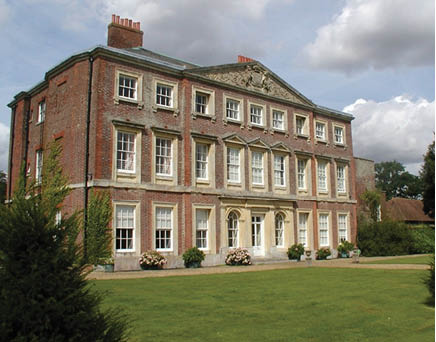
The manor house at Goodnestone Park Gardens.
Also located in Kent is Leeds Castle, famous for its fairytale setting on an islet in a lake, and furnished with medieval tapestries and treasures. Another Kent castle, located in Edenbridge, is Hever Castle – where Anne Boleyn spent her childhood. The castle had fallen into disrepair when purchased in 1903 by William Waldorf Astor, who tapped into his vast fortune to restore the castle and gardens to their former splendour. He also built a replica Tudor village of half-timbered cottages that was once part of the castle complex. A few miles from Hever Castle is Chartwell – the country estate of Sir Winston Churchill. Managed by the National Trust, this family home is where Churchill drew inspiration from the surrounding hillside gardens.
Close to Heathrow Airport is the town of Windsor, its narrow winding streets overshadowed by fortress-like Windsor Castle – the largest and oldest occupied castle in the world. Built by William the Conqueror, with additions and renovations carried out by successive royal rulers, Windsor Castle remains one of the monarch’s chief residences. The Queen spends most weekends at Windsor Castle, where 300 full-time staff (200 of which are resident) keep things running smoothly. A national monument, Windsor Castle’s sumptuous State Apartments are open to the public (admission is charged).

Leeds Castle in Kent
Other attractions within the castle complex include Queen Mary’s doll house and the splendid 14th-century St. George’s Chapel – one of the finest examples of Gothic architecture in England – which contains the tombs of ten sovereigns, including King Henry VIII and his third wife Jane Seymour. Changing the Guard takes place outside the Castle at 11:00 a.m. daily (except Sundays) from April to July, and on alternate days the rest of the year. The grounds of Windsor Castle cover 26 acres and also contain Frogmore House with its nearby mausoleum where Queen Victoria and Prince Albert are buried.
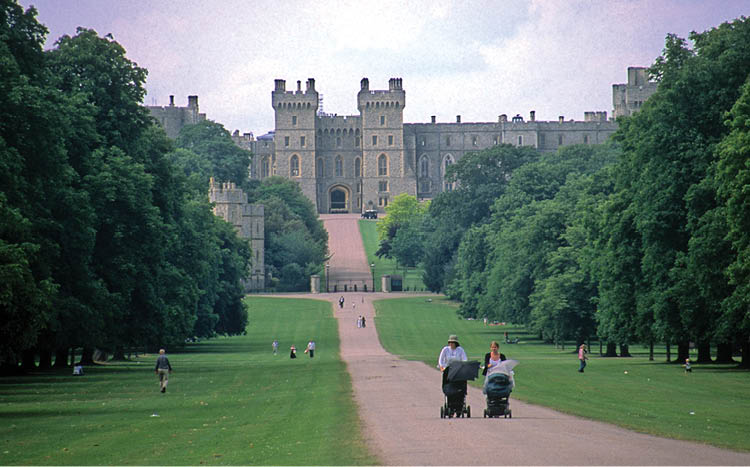
The Long Walk in Windsor Great Park leads to Windsor Castle.
To visit Windsor Castle from London, take the train from Paddington Station to the Windsor Royal Shopping Pavilion, which is a short walk to the castle.

